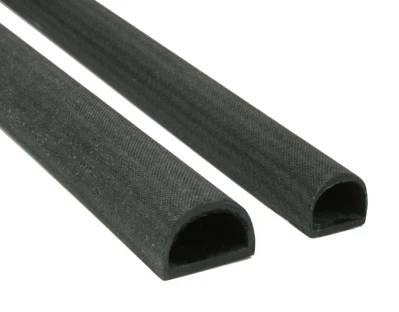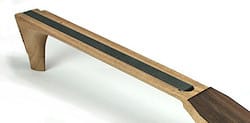How Carbon Fiber D-Tubes Affect Musical Instrument Tone
The Carbon Fiber “D” Tube - The Next Generation Truss Rod
 Carbon Fiber D-Tube Neck Beams™ were specifically designed to stabilize the necks of stringed musical instruments. When a carbon fiber D-tube is installed in a guitar neck, both bending and torsional stiffness of the neck are increased, while neck weight and vibration damping are decreased.
Carbon Fiber D-Tube Neck Beams™ were specifically designed to stabilize the necks of stringed musical instruments. When a carbon fiber D-tube is installed in a guitar neck, both bending and torsional stiffness of the neck are increased, while neck weight and vibration damping are decreased.
The carbon fiber “D” tube was developed as an improvement over the traditional steel truss rod. The original truss rod can correct a warped neck, but it does so by acting like an adjustable spring and applying a corrective force to the neck, pushing it back into the correct position. Unfortunately, because the truss rod itself is not intrinsically rigid, it will not hold the neck in that adjusted position. Essentially a truss rod can correct for a given neck warp, but will not stabilize the neck against further warp. This means that an unstable neck can warp again, and the truss rod will have to be re-adjusted again, thus the perception that truss rods might need to be adjusted periodically. The “D” tube, on the other hand, is extremely rigid and does actually stabilize the neck. Necks with “D” tubes installed typically do not warp or require further adjustment.
Also, when a metal truss rod is installed in a slender wooden neck, it noticeably increases the neck weight. The “D” tube, on the other hand, weighs less than the wood that was removed for its installation. Finally, the “D” tube is very torsionally rigid, whereas a truss rod is not. This torsional rigidity tends to make the neck more stable. This would be apparent, for example, in the pitch stability of the other strings when dropping the E string tension for drop D tuning.
What surprised us was that many luthiers and their customers told us that the “D” tube installation improved the tone of the instrument. We heard statements like “It opened up the middle range” and “It increased the power and clarity of the instrument.” The question is, what causes this improvement?
Instrument Structure and Possible Answers
The acoustic response of a stringed musical instrument depends on many things, including the strings, the soundboard, the neck, the body structure, and the volume of air inside the instrument. Bending stiffness and weight distribution of the soundboard combine to control the way it reacts to string vibrations. The top is essentially “tuned” to vibrate at different frequencies in different areas. It is for this reason that much emphasis is placed on top thickness and the location and design of the internal braces.
 The neck of the guitar contributes to instrument resonance primarily in the body modes, as the neck and body vibrate in bending. It also provides a relatively “rigid” mounting location for the strings at the nut. The vibrating strings still lose some energy through absorption at this termination, though. The nut moves slightly with the string because it is not completely rigid; therefore, some string vibration is transferred to the nut and absorbed by the neck.
The neck of the guitar contributes to instrument resonance primarily in the body modes, as the neck and body vibrate in bending. It also provides a relatively “rigid” mounting location for the strings at the nut. The vibrating strings still lose some energy through absorption at this termination, though. The nut moves slightly with the string because it is not completely rigid; therefore, some string vibration is transferred to the nut and absorbed by the neck.
When the neck is made stiffer and lighter by the carbon fiber “D” tube, its resonant frequency is increased. Also, internal vibration damping is reduced because the “D” tube is bonded integrally to the neck structure, and carbon fiber exhibits very low damping. This increased resonant frequency of the neck can increase the resonant frequencies of the complete instrument. In addition, the reduced damping of the neck can reduce the absorption of energy from the vibrating string at the nut, leaving more energy to be transmitted to the bridge and converted to sound by the soundboard.
Tonal Quality of Carbon Fiber
Acoustical tests performed at the Helsinki University of Technology showed that measured maximum volume in carbon fiber tubes was more powerful than their wood counterparts, and the measured tonal spectra were rich throughout a broad frequency range. This suggests that carbon fiber tubes support superior tonal production, particularly in the mid-range.
Superior Properties of Carbon Fiber Tubes
When seeking to stabilize instrument necks, the unique properties of carbon fiber make the carbon fiber D-tube an excellent choice for several reasons. The stiffness-to-weight ratio of carbon fiber allows us to produce a neck that is stiffer and lighter. Carbon fiber’s excellent fatigue resistance ensures that carbon-fiber-tube-reinforced instrument necks will maintain their superior stiffness for years to come, even when the instrument must withstand the strains of traveling extensively with its owner. Carbon fiber’s low coefficient of thermal expansion (CTE) ensures that Carbon Fiber D-Tube Neck Beams help maintain a stable sound quality in the instrument, even when played outdoors in extreme weather conditions.
Conclusion
Using carbon fiber D-tubes results in a stiffer and lighter neck, which results in higher resonant frequencies. The stiffer neck and reduced damping allow more string energy to be transferred to the soundboard and not lost by transfer at the nut. Finally, carbon fiber’s unique properties of stiffness, lightweight, fatigue resistance, and low CTE make Carbon Fiber D-Tube Neck Beams a preferred choice for stabilizing the necks of stringed instruments.
Throughout history, a number of methods for stabilizing the neck beams of stringed musical instruments have been developed. The stiffness of an instrument’s neck beam can have a significant effect on the tonal quality of an instrument. With the development of the carbon fiber “D” tube, instrument builders now have the option to use these specialized carbon fiber tubes to provide a lighter, more stable neck and to improve instrument tone.
To view DragonPlate’s selection of Carbon Fiber D-Tubes, visit https://dragonplate.com/carbon-fiber-d-tube.
See how instrument builders are using the Carbon Fiber D-Tube Neck Beam in their instruments >>